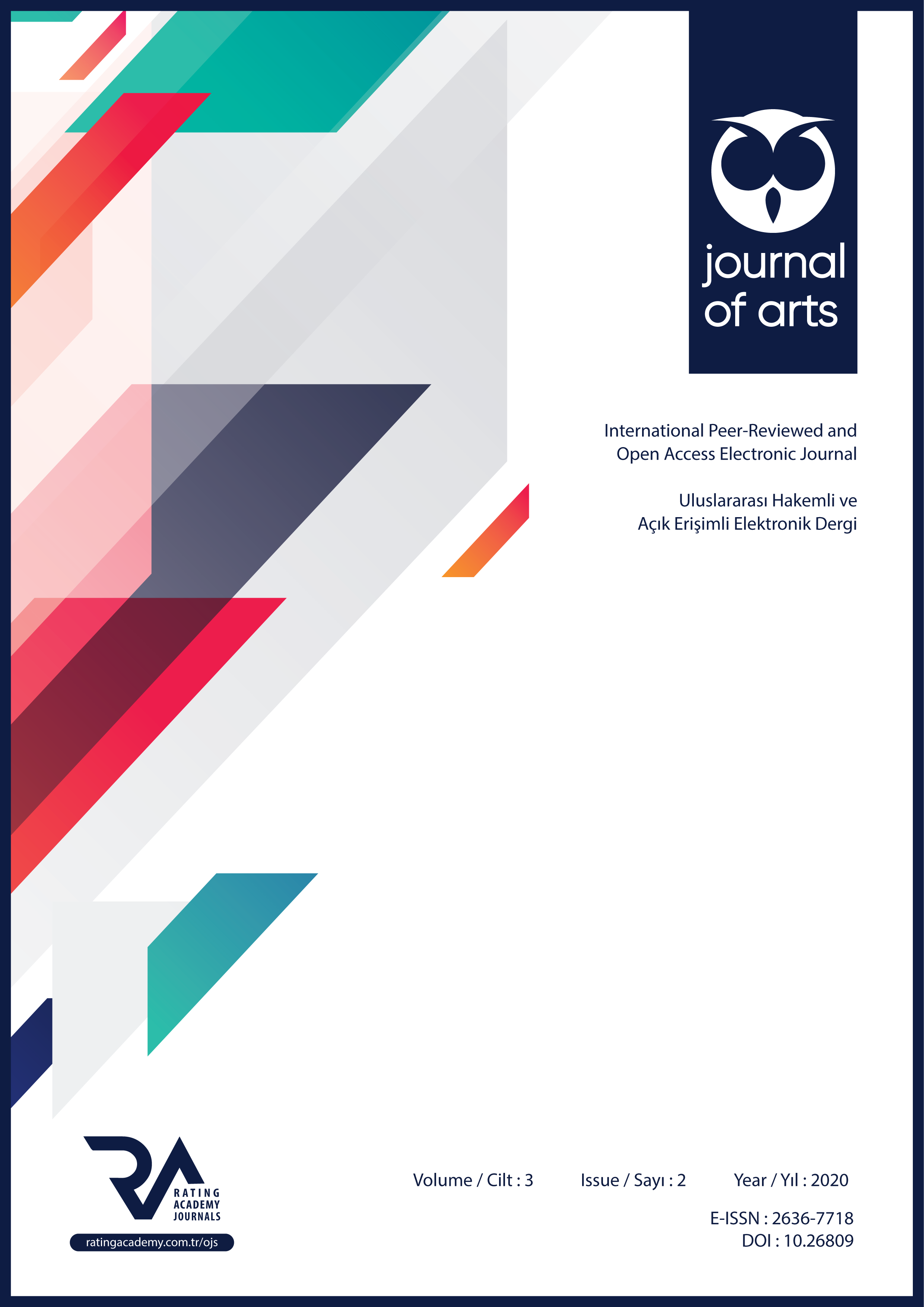Abstract
Today, the dynamic structure of art continues its course in the axis of the new pursuits of the artists, in parallel with the cultural transformations. It can be said that it will be difficult to grasp the phenomenon of art, when the relationship of “change”, which is one of the unchangeable features of art, with culture is not resolved. In the research, the interdisciplinary approaches of the artists in the post-digital process are evaluated with ideological-hegemonic-political elements and scientific-technological developments. It is seen that new technologies, which are known to have an impact on cultural transformations, enable important expansions in the definition of art, in the perception of the artist, in the form and content of the artwork.
In communication models, corporate transactions, socialization efforts, entertainment,in games, virtual experiences with screen interfaces preferred to reality are replaced by experiences in three-dimensional space perception with augmented reality technologies. There are developments in the field of artificial intelligence and superior human projects for human-machine collaboration are continuing. The boundaries between virtual-real and machine-human are tried to be melted. It is aimed to explain post-digital art in the relationship of cultural structure transformed with these fields of activity.
References
ARP, J. HANS, 2018, DADALAND, (çev. N. Artun Altınyıldız ve diğerleri), İstanbul: İletişim Yayınları
ATASOY, N. & TÜKEL, U, İtalya’da Rönesans Sanatı https://docplayer.biz.tr/2598268-Italya-da-ronesans-sanati-nurhan-atasoy-usun-tukel.html (Erişim tarihi: 02 Mart 2020)
AYDIN, Ç. M, ,2002, Sanatta Eleştirellik, İstanbul: Beta Yayımları.
AYDINLI, İ. H., 2003, "Örgüt Kültürünün Yönetim Açısından Önemi", Bilgi Sosyal Bilimler Dergisi, İstanbul, 5, (2), 79-99.
BİLGEN, H., 2014, Biyoteknoloji ve İnsan Hakları: Transhümanizm Hukuk Alanına Nasıl Girdi?. Erişim tarihi: 22.10.2017 http://www. medikalakademi.com.tr/biyoteknoloji-ve-insan-haklari-transhuemanizm-hukuk-alanina-nasil-girdi.
BOZKURT, M., 2012, "Video Sanatı: Performans, Enstalasyon ve Heykel", Yeni Medya Ve.... (Ed: Deniz Yengin), İstanbul: Anahtar Kitapları Yayınevi, 310-338.
CRAMER, F., 2014, “What is Post Digital?”, APRJA, 3 (1), 11-24
ÇITAK, E., 2014, “Postkolonyalizm ve Batı Sinemasında Doğu-Batı Ayrımına Yönelik Postkolonyal Öğeler”, Hitit Üniversitesi Sosyal Bilimler Enstitüsü Dergisi, 7 (2), 561-578.
DEMİR, A. 2018, Ölümsüzlük ve Yapay Zekâ Bağlamında Trans-hümanizm AJIT-e: Online Academic Journal of Information Technology 9 (30), 95-104
HERMAN, J. W., 1952,‘‘Lives of Famous French Painters-From Ingres To Picasso’’. 1st printing. U.S.A: Cardinal
HUGO, V., 2006, Sefiller, (çev.Ali Çankırılı), Istanbul: Antik Dünya Klasikleri.
KOTERBAY, S. C. and ŁUKASZ, M., 2016, The New Aesthetic and Art: Constellations of the Postdigital, Institute of Network Cultures, Amsterdam
LOVEJOY. M., 2004, Digital Currents Art in the Electronic Age, London and New York: Routledge.
LULL, J., 2001, "Super Culture For The Communication Age" Culture in the Communication Age, London and New York: Routledge.
LUND, H., 2015, Make It Real & Get Dirty! Post-Digital Culture. http://post-digital-culture.org/wordpress/wp-content/uploads/2015/08/hlund_2015_make-it-real.pdf (Erişim Tarihi: 04 Mart 2020)
MARZEC A., 2018, Postdigital aesthetics - an art of imperfection, disturbances and disintegration Unframing Archives – Essays On Cinema And Visual Arts 31-42
OKTAY, A., 2004, Sanat ve Siyaset, Everest Yayınları, İstanbul.
ÖNEMLİ, S., 2017, Post Dijital Çağa Hazır mısınız? https://digitalage.com.tr/post-dijital-caga-hazir-misiniz/ (Erişim Tarihi: 04 Mart 2020)
FERHAT, S., 2016, “Dijital Dünyanın Gerçekliği, Gerçek Dünyanın Sanallığı Bir Dijital Medya Ürünü Olarak Sanal Gerçeklik” TRT Akademi Dergisi 1 (2), 724-746
SIMBELIS, V., 2018, “Humanizing Technology Through Post-Digital Art”, Doctoral Thesis,, KTH Royal Institute of Technology School of Electrical Engineering and Computer Science Media Technology and Interaction Design, Stockholm, Sweden
ŞATIR, S., 2004, Düşünmenin Öyküsü: Başlangıçta Bilgisizlik Ve Korku Vardı, İstanbul: Pan Yayıncılık.
TURANİ, A., 2001, Çağdaş Sanat Felsefesi, İstanbul: Remzi Kitapevi.
TÜRK, B., 2018, Post-Dijital Çağın Yenilikçi Tüketicileri, İnovasyon: Ekonomik ve Sosyal Eğilimler (editörler: Enes Emre Başar, Atakan Durmaz) Ankara: İmaj Yayınevi 1-26
TÜRKER, M., 2013, Vücudun Sınırlarını Zorlayan Sanatçı, https://m.bianet.org/biamag/sanat/143658-vucudunun-sinirlarini-zorlayan-sanatci (Erişim Tarihi: 19 Mart 2020)
VEGAS, D., 2019, Metaphone art Project http://metaphone.net/about/ (Erişim Tarihi: 23 Mart 2020)
VISCONTI, S., 2015, “Etkileyici Fotografik Aksaklık Sanatı (glitch art)”
https://www.yatzer.com/sabato-visconti/slideshow/14 (Erişim Tarihi: 24 Mart 2020)
YILMAZ, M., 2006, Modernizmden Postmodernizme Sanat, Ankara: ÜtopyaYayınevi.
ZHILYAEVA, A., 2017, “Artırılmış Gerçeklik Sanatı” https://www.annadreambrush.com/wiki/index.php?title=Anna_Zhilyaeva (Erişim Tarihi: 25 Mart 2020)

This work is licensed under a Creative Commons Attribution 4.0 International License.
Copyright (c) 2020 Holistence Publications


